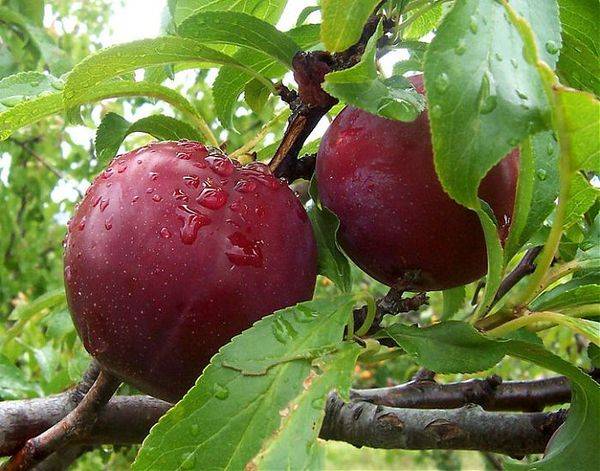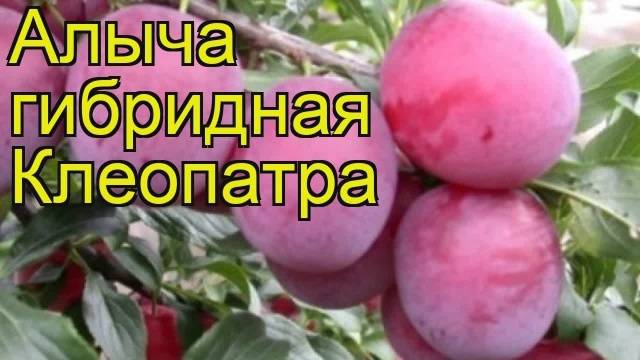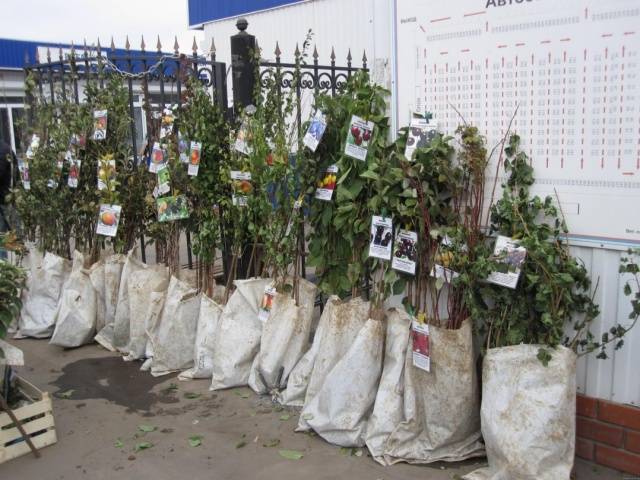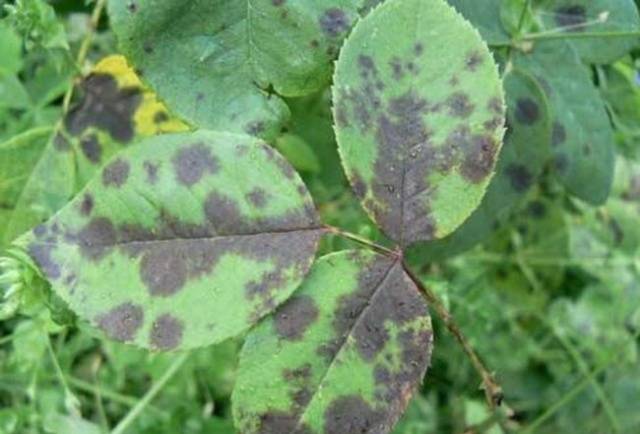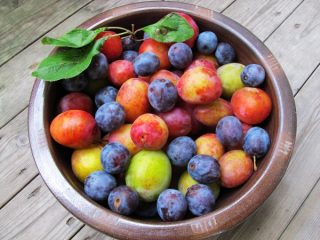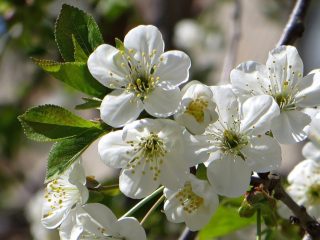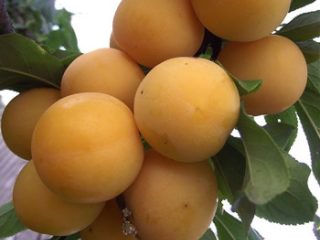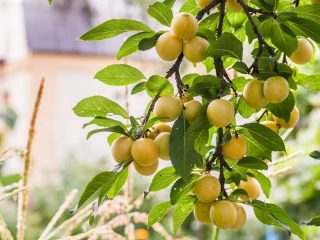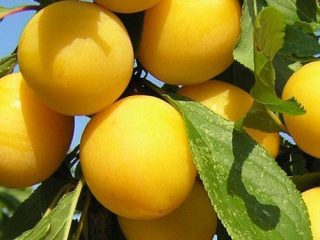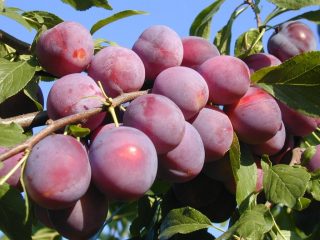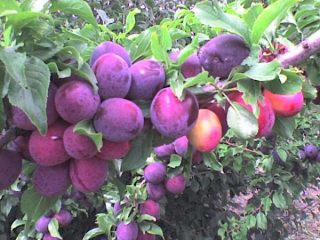Content
Cherry plum Cleopatra is a fruit belonging to a group of hybrids known collectively as “Russian plum”. The variety of this fruit is unique with its excellent taste and late ripening.
History of selection
Today there is a variety of cherry plum varieties, which makes it difficult for gardeners and summer residents to choose. In this case, it is necessary to take into account the specific planting conditions, characteristics of the variety, its characteristics and preferences. The peculiarities of cherry plum are that it is a delicate fruit that is not susceptible to cold weather. The history of this cherry plum variety began with its breeding at the Moscow Agricultural Academy. K.A. Timiryazev from a seedling from free pollination of the Kuban Comet variety in 1991, and thanks to its breeding, gardeners and summer residents received a variety that is persistent, unpretentious and frost-resistant. Below is a photo of the Cleopatra cherry plum during the harvest season.
Description of culture
Growing the presented cherry plum variety is excellent for the Moscow region and central Russia. It is also possible to grow in the north-west, the Urals, the mid-Volga region, the Southern Urals, Altai and the Far East.
Description of the cherry plum Cleopatra is a medium-sized tree, the crown is sparse and spreading, the height of the fruit ranges from 2-3 m, the shoots are thin, the leaves resemble the shape of an ellipse of dark green color. The average weight of the fruit is 37-40 g, the fruit of the tree has a round oval shape, the stone is of medium size and is separated from the pulp of the fruit. The color of the presented cherry plum is dark red-violet, with a slight waxy coating, the skin of the berry is medium thick, the taste of the collected fruit is sweet with a slight admixture of sourness.
Characteristics
The characteristics of the cherry plum variety Cleopatra lie in determining the main factors that many gardeners pay attention to before carrying out the process of planting this variety on their own garden plot. Before planting, it is advisable to consult or take the advice of experienced gardeners.
Drought resistance, winter hardiness
This plum variety belongs to the winter-hardy species. The tree can withstand air temperatures of about 400From the frost. If the temperature is low enough, the branches will be moderately exposed to the cold, but the shoots will be slightly exposed. Spring frost damage to flower buds is also mild. As for drought resistance indicators, this level has above average indicators.
Pollination, flowering period and ripening time
The cherry plum variety Cleopatra belongs to the group of self-sterile plants, so it requires an additional pollinator.When choosing a domestic type of cherry plum, you need to understand that it will not be a suitable option as a pollinator. Among the optimal pollinators for the Cleopatra cherry plum, one can distinguish any type of hybrid plum or a species called Chinese plum.
The flowering process is quite early, as it occurs around mid-May. The fruits also ripen very early, around mid-August or early September.
Productivity and fruiting
The first harvest may occur within 3-4 years, but this variety is characterized by high fertility. In the first year of harvest and subsequent years, you can collect from 25 to 40 kg from one tree. The harvested crop can be stored at average temperature for 1-1.5 months. The maximum lifespan of this cherry plum variety is 45-60 years.
Area of application of fruits
Hybrid cherry plum Cleopatra belongs to the dessert species. It is used as the main ingredient in the preparation of jams, juices, compotes, soufflés and preserves. It is consumed raw or can be frozen for the winter.
Resistance to diseases and pests
This type of cherry plum variety is quite resistant to pests and all kinds of diseases, since they practically do not affect it. Hole spot, which affects leaves, has never been observed in this species; fruit rot was found in one in a hundred cases. Aphids and the widespread codling moth are also very rare, especially if the plant care is correct and of high quality.
Advantages and disadvantages
Advantages of the variety:
- quality characteristics of fruits;
- high productivity and early pregnancy;
- resistance to all kinds of damage;
- excellent drought and winter hardiness.
The most common shortcomings identified by professional gardeners:
- self-sterility;
- resistance to diseases is average.
Landing Features
In order for the growth process of Cleopatra cherry plum to occur normally, it is necessary to adhere to certain characteristics and rules for planting this variety, because its further productivity will depend on this.
Recommended timing
As for the recommended timing for planting this variety of cherry plum, it can be planted in the soil both in the autumn (September-October) and in the spring (April-May).
Choosing a suitable location
It is advisable to plant in the most southern parts of the plots, since the fruit loves the sun. You should not try to place the seedling under the large crowns of other trees, as it will not have enough sunlight in the future. The presence of groundwater in the planted area will be a big plus. Cherry plum will grow well and bear fruit on black soil, chestnut and sandy soils.
What crops can and cannot be planted next to cherry plum
When planting cherry plum, you should remember that there are crops that can and that are not recommended to be planted near this variety. The ideal option would be when pollinators with the same flowering period are planted near this cherry plum variety. It is not recommended to plant stone fruit crops, which include pears and apple trees, near cherry plums. Gooseberries, raspberries and all shrub representatives can be good neighbors for this variety.
Selection and preparation of planting material
To plant this cherry plum fruit, you will need to purchase a ready-made 1-2 year old seedling in a container and immediately transplant it into a prepared place. It is important to inspect the seedling for damage to the bark and roots; if necessary, trim the roots for better grafting in a new place.
It is recommended to buy seedlings in special gardening nurseries or stores; it is not recommended to buy them from hand or on the road due to the likelihood of acquiring game or other fruit.
Landing algorithm
For planting, a hole is required (dimensions 60x80 cm, depth 50 cm).
Lower the tree into the hole, with a tied peg for proper growth, cover it with a little soil and compact it.
Prepare fertilizer from half the soil, humus in an amount of 4-5 kg and 15 g of various fertilizers, which should be poured into the hole.
After installing the tree in the hole, fill it with freshly dug soil.
Pour 1-2 buckets of water around the seedling and mulch the ground.
When planting several seedlings at the same time, leave a distance of 3-4 meters between them.
Subsequent care of the crop
Subsequent care of the planted cherry plum Cleopatra consists of the following constant actions: the soil should be loosened and weeds should be removed. The shoots are pruned every spring to prevent the crown from thickening.
In the first year after planting the Cleopatra cherry plum, no fertilizing is done. Feeding should be done in the 2nd year and beyond. For feeding you need to use urea or ammonium nitrate, according to the following recipe: 1-2 spoons per 10 liters of water for one tree.
In subsequent years, fertilizing must be done 2-3 times during the season. It is correct to fertilize at the beginning of the flowering season. After applying fertilizers, do not forget to mulch the soil.
Diseases and pests, methods of control and prevention
The presented cherry plum variety is quite resistant to various diseases and pests, but some of them can be found.
Experienced gardeners recommend timely prevention with special preparations to prevent tree diseases. Preventive measures must be carried out in early spring.
Conclusion
Cherry plum Cleopatra is a variety of cherry plum that is suitable for gardening and dacha conditions. Cherry plum Cleopatra is characterized by good growth, resistance to diseases and cold, and an average but stable yield. The cherry plum fruit is large, has an excellent dessert taste, and a delicious fruity aroma.
